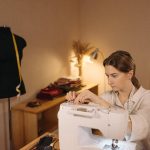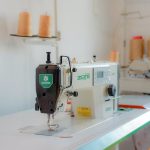Ever wondered about the distinctions between a sewing machine and a serger?
The two may seem similar at first glance, but each serves a unique purpose in the realm of stitching and crafting.
From the way they handle threads to the types of stitches they produce, the differences between these machines can significantly impact your projects.
So, what sets them apart and how do you know which one suits your needs best?
Let's uncover the intricacies that make these tools indispensable for any sewing enthusiast.
Table of Contents
Key Takeaways
- Sewing machines offer versatile stitching options, suitable for various tasks.
- Sergers excel in creating durable seams and professional finishes.
- Choosing between a sewing machine and a serger depends on project needs.
- Sergers require maintenance but provide long-term value for professional sewing projects.
Basic Definition of Each Machine
When differentiating between a sewing machine and a serger, understanding the basic definitions of each machine is essential for choosing the right tool for your sewing projects.
A sewing machine operates with a mechanically driven needle, stitching fabrics together primarily using 1 or 2 threads. It's versatile and can be used for various sewing techniques such as topstitching, adding facings, and creating buttonholes.
On the other hand, a serger, also known as an overlock machine, works by binding fabric edges with an overlock stitch using 3 to 4 threads. Sergers excel at creating neat seams, looping threads around fabric edges, and trimming excess fabric for a professional finish.
One significant difference between the two is the speed at which they operate, with sergers being faster due to their specialized functions. Understanding these distinctions will help you select the most suitable machine for your specific sewing needs.
Primary Functions of a Sewing Machine
When it comes to sewing machines, they're the heart of any sewing project. From mastering basic stitches to exploring intricate stitching techniques, sewing machines are versatile tools that offer a world of creativity.
Let's unravel the essentials of sewing machine basics, stitching techniques, and machine maintenance tips to help you unleash your sewing potential.
Sewing Machine Basics
Exploring the primary functions of a sewing machine reveals its versatility in handling tasks such as stitching seams, adding buttons, creating buttonholes, and decorative stitching. Sewing machines are essential for a variety of sewing projects, offering different stitches and techniques to choose from. They excel at providing precise topstitching and detailed embellishments, making them perfect for projects involving zippers, facings, and intricate garment designs. From basic mechanical models to advanced computerized versions with embroidery digitization features, sewing machines cater to a wide range of needs. Below is a table summarizing the basic functions and features of a sewing machine:
| Basic Tasks | Versatile Tools | Advanced Features |
|---|---|---|
| Stitching Seams | Different Stitches | Embroidery Digitization |
| Adding Buttons | Precise Topstitching | |
| Creating Buttonholes | Detailed Embellishments | |
| Decorative Stitching |
Stitching Techniques
Let's now explore the primary functions of a sewing machine by looking at its stitching techniques.
- Topstitching: Achieves a professional finish by sewing a visible line of stitching on the right side of the fabric.
- Decorative stitching: Adds unique embellishments to your projects, enhancing their aesthetic appeal.
- Buttonholes: Sewn easily with a sewing machine using a special buttonhole foot, ideal for garments or home decor items.
- DIY projects: Sewing machines like the Brother 1034D are perfect for crafting enthusiasts to create personalized items.
- Heavy-duty tasks: While sewing machines are versatile, industrial sergers are more suitable for heavy-duty tasks due to their robust construction.
Machine Maintenance Tips
To maintain optimal performance, it is essential to regularly clean your sewing machine by removing lint and dust buildup. Proper maintenance not only prolongs the life of your machine but also ensures smooth and precise stitching. Remember to oil the sewing machine as per the manufacturer's instructions to keep all moving parts running smoothly. Check and adjust the tension settings to achieve balanced stitches on various fabrics. Regularly replace needles to prevent thread breakage and maintain consistent stitching quality. When not in use, always cover your sewing machine to shield it from dust and debris, preserving its efficiency. Follow these maintenance tips to keep your sewing machine in top condition.
| Maintenance Tips | Description | Importance |
|---|---|---|
| Regular Cleaning | Remove lint and dust buildup to prevent performance issues | Essential |
| Oiling | Lubricate moving parts for smooth operation | Vital |
| Tension Settings | Adjust for balanced stitching on different fabrics | Critical |
| Needle Replacement | Regularly replace dull or bent needles to avoid thread breakage | Crucial |
| Machine Cover | Keep covered when not in use to protect from dust and debris | Important |
Primary Functions of a Serger
When using a serger, one of its primary functions is to create neat and durable seams by binding fabric with an overlock stitch using 3 or 4 threads. Sergers offer various benefits and functionalities that set them apart from traditional sewing machines:
- Clean Edge Finish: Sergers cut fabric while sewing, providing a clean edge finish that prevents fraying, which isn't achievable with a sewing machine.
- Efficiency: Operating at a faster speed, sergers are efficient for projects requiring both speed and precision, making them a valuable tool in garment construction.
- Specialized Function: With a short neck that allows sewing only on the left side of the needle, sergers offer a specialized function for specific sewing tasks that require intricate stitching.
- Strong and Secure Stitches: Sergers use 3-4 threads to create strong and secure stitches, ideal for professional garment construction and finishing edges with durability.
- Professional Results: The precision and versatility of a serger make it a must-have for those looking to achieve professional-quality results in their sewing projects.
Types of Stitches Each Machine Creates
When it comes to the types of stitches each machine creates, sewing machines offer a wide array of options like straight, zigzag, and decorative stitches.
On the other hand, sergers are experts in producing overlock stitches for seam finishing and specialized stitches like rolled hems and cover stitches.
Understanding these distinctions can help you choose the right machine for your stitching needs.
Stitch Variety
The serger's stitch variety includes specialized stitches such as the cover stitch, flatlock stitch, overlock stitch, and rolled hem, perfect for achieving professional finishes.
- Cover Stitch
- Flatlock Stitch
- Overlock Stitch
- Rolled Hem
These stitches cater to specific needs like creating strong seams, neat edge finishes, and decorative elements.
While sewing machines offer versatility in stitch selection for various sewing tasks, sergers excel in producing durable seams suitable for different fabric types. The specialized stitches of a serger focus on enhancing the durability and neatness of seams, ensuring a professional-looking outcome. Understanding the unique capabilities of both machines allows for optimal utilization in different sewing projects.
Seam Finishing
Sergers specialize in creating overlock stitches to achieve neat seam finishing, preventing fraying, and giving a professional touch to sewing projects. These machines excel in encasing raw edges with multiple threads, ensuring durability and a polished look.
Additionally, sergers can perform cover stitches, rolled hems, flatlock stitches, and various overlock stitches for different seam finishing techniques. On the other hand, sewing machines offer versatility in creating decorative seams, topstitching, buttonholes, zippers, and facings.
While sewing machines are adept at a wide range of stitches for diverse sewing techniques, sergers focus on specialized seam finishing, making them indispensable for achieving clean and professional results in garments and other sewing projects.
Seam Finishing Abilities
With their precision in creating overlock stitches, sergers elevate seam finishes to a professional level, ensuring durability and a polished appearance. Sergers offer a range of benefits for seam finishing, making them indispensable for achieving high-quality results:
- Fraying Prevention: Sergers seal the fabric edges while stitching, preventing fraying and ensuring the longevity of the garment.
- Professional Look: The neat and trimmed finish provided by sergers gives garments a professional appearance, ideal for both home sewing projects and professional clothing production.
- Knit Fabrics: Sergers are a go-to choice for working with stretchy knit fabrics, as they create flexible and strong seams that can withstand the fabric's stretch without breaking.
- Efficiency: Sergers trim, stitch, and finish seams in one swift pass, saving time and effort compared to using a sewing machine for multiple steps.
- Versatility: While sewing machines offer decorative stitches and unique finishes, sergers excel at creating clean, durable seams suitable for a wide range of fabrics, especially knit materials.
Ease of Threading
Threading a serger can initially seem daunting due to the multiple threads that need to be passed through loopers and needles simultaneously. Unlike a sewing machine, which usually requires threading only one or two threads, a serger demands more intricate handling of threads. The complexity and time-consuming nature of serger threading arise from aligning each thread correctly to ensure optimal stitch formation.
Fortunately, many sergers come equipped with color-coded guides that aid in distinguishing the threading paths for different threads, easing the process for users. Despite the initial challenges, mastering the threading of a serger is crucial for achieving professional and durable seams.
Some advanced serger models offer automatic threading features, streamlining the setup process significantly. Automatic threading systems can save time and frustration, especially for those new to serging. While threading a serger may seem intimidating at first, with practice and familiarity, it becomes more manageable. Proper threading is vital for the serger to function smoothly and deliver high-quality finished projects.
Fabric Handling Differences
When working with fabric, the differences in handling between a sewing machine and a serger become evident in how they approach edge finishing techniques.
- Sergers excel at trimming fabric edges while sewing, resulting in neat and professional finishes.
- Sergers use multiple threads to loop around fabric edges, preventing fraying and providing added durability.
- Sewing machines, on the other hand, don't trim fabric while sewing, necessitating separate trimming steps after stitching.
- Sergers are particularly effective in handling knits and stretch fabrics due to their specialized capabilities.
- Sewing machines, although less specialized, offer versatility in fabric handling, making them suitable for a wide range of sewing projects.
Understanding these fabric handling differences between a sewing machine and a serger can help you choose the right tool for your specific project needs. Whether you prioritize precision and efficiency with a serger or versatility with a sewing machine, each device brings unique advantages to the sewing table.
Versatility Comparison
When comparing the versatility of sewing machines and sergers, it's crucial to consider the stitch types available, the varied seam finishing techniques each offers, and their fabric handling capabilities.
Each machine has its strengths, with sewing machines excelling in a range of sewing tasks and sergers specializing in creating professional finishes and durable stitches.
Understanding these distinctions can help you choose the right tool for your specific sewing projects.
Stitch Type Differences
In comparing the stitch type differences between sewing machines and sergers, it becomes evident that sergers specialize in overlock stitches for neat seam finishes, while sewing machines offer a broader range of stitches suitable for various sewing techniques and decorative purposes.
- Sergers focus on overlock stitches for professional seam finishes.
- Sewing machines excel at topstitching, buttonholes, and decorative stitching.
- Sergers have limited stitch versatility compared to sewing machines.
- Sewing machines can switch between different stitch types easily.
- Sewing machines provide flexibility in stitch selection for diverse garment construction and decorative purposes.
Seam Finishing Techniques
Sergers and sewing machines each offer distinct advantages when it comes to seam finishing techniques, highlighting their unique versatility in creating professional-looking stitches. Sergers excel in seam finishing with overlock stitches, preventing fraying and providing a polished appearance. These machines trim, stitch, and finish fabric edges simultaneously, ensuring quick and neat seam finishes.
On the other hand, sewing machines are versatile for various seam finishing techniques, such as topstitching, decorative stitching, and crafting buttonholes. While sergers are specialized in seam finishing, sewing machines provide a broader spectrum of decorative and functional stitches, allowing for more creativity in designs.
Both machines play crucial roles in achieving professional and tailored garments through their distinct seam finishing capabilities.
Fabric Handling Capabilities
With their specialized features and capabilities, sewing machines and sergers each bring a unique touch to fabric handling in the realm of sewing.
- Sergers excel in handling stretch fabrics with built-in stretch stitches, ensuring flexibility and durability in projects.
- Serging machines are designed for finishing seams neatly and trimming raw edges simultaneously, providing a polished look to the final product.
- Sewing machines offer versatility for a wide range of sewing techniques, including topstitching, adding zippers, and creating buttonholes.
- Sewing machines showcase adaptability with tasks like decorative stitching, facing applications, and intricate embroidery work.
- Sergers are designed for finishing seams neatly and trimming raw edges simultaneously, providing a polished look to the final product.
- While sergers create neatly finished seams and edges, sewing machines are suitable for a broader range of applications, emphasizing the complementary nature of these two machines in a sewing workspace.
Cost Variances
Wondering why sewing machines are typically more budget-friendly than sergers? Sewing machines are often the go-to choice for beginners due to their affordability and versatility. Sergers, on the other hand, come with specialized functions and capabilities that justify their higher cost.
When considering cost variances between the two, it's essential to weigh the features each offers against your sewing needs. Sergers can vary in price depending on factors like brand, model, included features, and accessories, making them a significant investment for those who require professional finishes and decorative edges.
Sewing machines, ranging from basic models to advanced computerized ones, cater to various budgets and skill levels, providing essential stitching functions for garment construction and basic alterations. Ultimately, deciding between a sewing machine and a serger involves considering not just the upfront cost but also the long-term benefits and value each can bring to your sewing projects.
Maintenance Requirements
To keep both your sewing machine and serger operating smoothly, regular maintenance is essential for optimal performance and longevity. Here are key maintenance requirements for both machines:
- Sergers: Regular oiling and cleaning are crucial to maintain optimal performance. Blade sharpening or replacement may be necessary for clean fabric cutting.
- Sewing Machines: Periodic oiling and bobbin changes are needed for smooth operation. Needle changes and thread adjustments are often required for different fabrics.
Both sergers and sewing machines benefit from these maintenance practices to prolong their lifespan and efficiency. By staying on top of oiling, cleaning, and part replacements, you can ensure that your machines continue to produce high-quality stitches for years to come. Remember, a well-maintained machine is a reliable machine!
Skill Level Considerations
When considering skill level, it's important to understand the distinct suitability of sewing machines and sergers for different levels of expertise. Sewing machines are often recommended for beginners as they're straightforward to use and versatile for basic sewing tasks like topstitching and adding zippers. They're great for making buttonholes, which can be more challenging on a serger.
On the other hand, sergers are better suited for advanced users or those aiming for professional finishes on their projects. Sergers shine when working with stretchy fabrics, creating rolled hems, and trimming raw edges neatly. While sewing machines offer a wider variety of stitches and functions, sergers excel in producing strong, durable seams with a polished look.
If you're a beginner looking to start your sewing journey, a sewing machine might be the best choice, whereas advanced users seeking professional-quality results may lean towards investing in a serger.
Choosing the Right Machine for Your Project
For selecting the appropriate machine for your project, consider the specific sewing techniques required, the fabric type, and the desired finish. When deciding between a sewing machine and a serger, it's essential to match the machine to the task at hand. Here are some key points to keep in mind:
- Sewing Machine: Ideal for tasks like topstitching, adding facing, making buttonholes, and decorative stitching.
- Serger: Perfect for creating neat seams, trimming fabric edges, finishing edges, and adding decorative stitches simultaneously.
- Fabric Type: Choose a sewing machine for versatile sewing techniques and a serger for working with stretchy fabrics or hemming knits.
- Desired Finish: If you need precise and professional-looking seams, a serger is the way to go.
- Heavy-Duty Tasks: Industrial sergers are recommended for heavy-duty projects, while models like the Brother 1034D are great for DIY enthusiasts.
Frequently Asked Questions
Which Is Better a Sewing Machine or a Serger?
I find that for most sewing tasks, a sewing machine is my go-to. It handles a variety of stitches and techniques with ease. However, a serger shines in specific areas like finishing edges and working with stretchy fabrics.
Can You Use a Regular Sewing Machine as a Serger?
I can't use a regular sewing machine as a serger. A serger has unique features like cutting fabric while sewing and creating strong edges not found in a standard machine. To replicate a serger's functions, I'd need extra tools and techniques.
Do I Need a Serger if I Have a Sewing Machine?
I've found that having both a sewing machine and a serger is a game-changer. While a sewing machine is versatile, a serger's finished edges and durability add a professional touch. Together, they elevate the quality of my projects.
Can You Sew Clothes With Just a Serger?
Yes, I can sew clothes with just a serger. It trims, stitches, and overcasts for professional results. Sergers handle tasks efficiently, create durable seams on knits, and offer speed. They're essential for garment construction, especially for stretch fabrics.
- Recycling Nonwoven Fabrics: Is It Possible? - July 11, 2025
- Recycling Nonwoven Fabrics: Is It Possible? - July 11, 2025
- Recycling Nonwoven Fabrics: Is It Possible? - July 11, 2025






